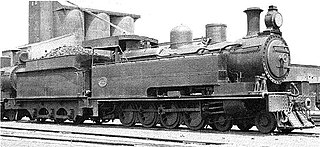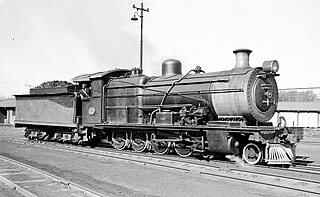
The South African Railways Class 17 4-8-0TT of 1926 was a steam locomotive from the pre-Union era in the Natal Colony.

The South African Railways Class A 4-8-2T of 1888 is a steam locomotive class from the pre-Union era in the Colony of Natal.

The South African Railways Class 13 4-8-0TT of 1905 was a steam locomotive from the pre-Union era in Transvaal.

The South African Railways Class H2 4-8-2T of 1909 was a steam locomotive from the pre-Union era in the Colony of Natal.

The South African Railways Class 8Y 2-8-0 of 1903 was a steam locomotive from the pre-Union era in the Cape of Good Hope.

The South African Railways Class 8E 4-8-0 of 1903 was a steam locomotive from the pre-Union era in the Cape of Good Hope.

The South African Railways Class 6Z 2-6-4 of 1901 was a steam locomotive from the pre-Union era in the Cape of Good Hope.

The South African Railways Class 6Y 2-6-2 of 1903 was a steam locomotive from the pre-Union era in the Cape of Good Hope.
The South African Railways Class 1 4-8-0 of 1904 was a steam locomotive from the pre-Union era in the Colony of Natal.

The South African Railways Class 1A 4-8-0 of 1910 was a steam locomotive from the pre-Union era in the Colony of Natal.
The South African Railways Class 2 4-6-2 of 1905 was a steam locomotive from the pre-Union era in the Colony of Natal.
The South African Railways Class 2C 4-6-2 of 1910 was a steam locomotive from the pre-Union era in the Colony of Natal.

The South African Railways Class 3 4-8-2 of 1909 was a steam locomotive from the pre-Union era in the Colony of Natal.
The South African Railways Class 3A 4-8-2 of 1910 was a steam locomotive from the pre-Union era in the Colony of Natal.

The South African Railways Class 3B 4-8-2 of 1912 was a steam locomotive.

The South African Railways Class G 4-8-2T of 1904 was a steam locomotive from the pre-Union era in the Colony of Natal.
The South African Railways Class Experimental 6 4-8-0 of 1906 was a steam locomotive from the pre-Union era in the Cape of Good Hope.
The South African type SH tender was a steam locomotive tender from the pre-Union era in the Natal Colony.

The South African type TJ tender was a steam locomotive tender from the pre-Union era in the Natal Colony.
The South African type TM tender was a steam locomotive tender from the pre-Union era in the Natal Colony.















